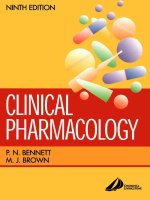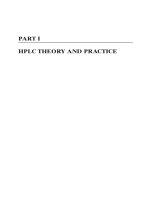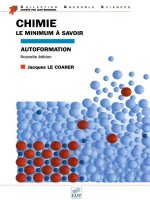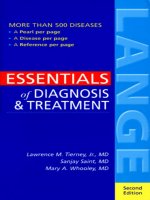THE PEDIATRIC DIAGNOSTIC EXAMINATION - PART 1 docx
Bạn đang xem bản rút gọn của tài liệu. Xem và tải ngay bản đầy đủ của tài liệu tại đây (1.38 MB, 83 trang )
THE PEDIATRIC
DIAGNOSTIC
EXAMINATION
NOTICE
Medicine is an ever-changing science. As new research and
clinical experience broaden our knowledge, changes in treat-
ment and drug therapy are required. The authors and the pub-
lisher of this work have checked with sources believed to be
reliable in their efforts to provide information that is com-
plete and generally in accord with the standards accepted at
the time of publication. However, in view of the possibility
of human error or changes in medical sciences, neither the
authors nor the publisher nor any other party who has been
involved in the preparation or publication of this work war-
rants that the information contained herein is in every respect
accurate or complete, and they disclaim all responsibility for
any errors or omissions or for the results obtained from
use of the information contained in this work. Readers are
encouraged to confirm the information contained herein with
other sources. For example and in particular, readers are
advised to check the product information sheet included in
the package of each drug they plan to administer to be cer-
tain that the information contained in this work is accurate
and that changes have not been made in the recommended
dose or in the contraindications for administration. This
recommendation is of particular importance in connection
with new or infrequently used drugs.
THE PEDIATRIC
DIAGNOSTIC
EXAMINATION
Editors
Donald E. Greydanus, MD
Professor, Pediatrics & Human Development
Michigan State University College of Human Medicine
Pediatrics Program Director
Michigan State University/Kalamazoo Center for Medical Studies
Kalamazoo, Michigan
Arthur N. Feinberg, MD
Professor, Pediatrics & Human Development
Michigan State University College of Human Medicine
Pediatric Clinic Director
Michigan State University/Kalamazoo Center for Medical Studies
Kalamazoo, Michigan
Dilip R. Patel, MD
Professor, Pediatrics & Human Development
Michigan State University College of Human Medicine
Michigan State University/Kalamazoo Center for Medical Studies
Kalamazoo, Michigan
Douglas N. Homnick, MD, MPH
Professor, Pediatrics & Human Development
Michigan State University College of Human Medicine
Director, Division of Pediatric Pulmonology
Cystic Fibrosis Center Director
Pediatrics Program
Michigan State University/Kalamazoo Center for Medical Studies
Kalamazoo, Michigan
New York Chicago San Francisco Lisbon London Madrid Mexico City
Milan New Delhi San Juan Seoul Singapore Sydney Toronto
Copyright © 2008 by The McGraw-Hill Companies, Inc. All rights reserved. Manufactured
in the United States of America. Except as permitted under the United States Copyright Act
of 1976, no part of this publication may be reproduced or distributed in any form or by any
means, or stored in a database or retrieval system, without the prior written permission of the
publisher.
0-07-159354-3
The material in this eBook also appears in the print version of this title: 0-07-147176-6.
All trademarks are trademarks of their respective owners. Rather than put a trademark
symbol after every occurrence of a trademarked name, we use names in an editorial fashion
only, and to the benefit of the trademark owner, with no intention of infringement of the
trademark. Where such designations appear in this book, they have been printed with initial
caps.
McGraw-Hill eBooks are available at special quantity discounts to use as premiums and sales
promotions, or for use in corporate training programs. For more information, please contact
George Hoare, Special Sales, at or (212) 904-4069.
TERMS OF USE
This is a copyrighted work and The McGraw-Hill Companies, Inc. (“McGraw-Hill”) and its
licensors reserve all rights in and to the work. Use of this work is subject to these terms.
Except as permitted under the Copyright Act of 1976 and the right to store and retrieve one
copy of the work, you may not decompile, disassemble, reverse engineer, reproduce,
modify, create derivative works based upon, transmit, distribute, disseminate, sell, publish or
sublicense the work or any part of it without McGraw-Hill’s prior consent. You may use the
work for your own noncommercial and personal use; any other use of the work is strictly
prohibited. Your right to use the work may be terminated if you fail to comply with these
terms.
THE WORK IS PROVIDED “AS IS.” McGRAW-HILL AND ITS LICENSORS MAKE
NO GUARANTEES OR WARRANTIES AS TO THE ACCURACY, ADEQUACY OR
COMPLETENESS OF OR RESULTS TO BE OBTAINED FROM USING THE WORK,
INCLUDING ANY INFORMATION THAT CAN BE ACCESSED THROUGH THE
WORK VIA HYPERLINK OR OTHERWISE, AND EXPRESSLY DISCLAIM ANY
WARRANTY, EXPRESS OR IMPLIED, INCLUDING BUT NOT LIMITED TO
IMPLIED WARRANTIES OF MERCHANTABILITY OR FITNESS FOR A PARTICU-
LAR PURPOSE. McGraw-Hill and its licensors do not warrant or guarantee that the
functions contained in the work will meet your requirements or that its operation will be
uninterrupted or error free. Neither McGraw-Hill nor its licensors shall be liable to you or
anyone else for any inaccuracy, error or omission, regardless of cause, in the work or for any
damages resulting therefrom. McGraw-Hill has no responsibility for the content of any
information accessed through the work. Under no circumstances shall McGraw-Hill and/or
its licensors be liable for any indirect, incidental, special, punitive, consequential or similar
damages that result from the use of or inability to use the work, even if any of them has been
advised of the possibility of such damages. This limitation of liability shall apply to any claim
or cause whatsoever whether such claim or cause arises in contract, tort or otherwise.
DOI: 10.1036/0071471766
We hope you enjoy this
McGraw-Hill eBook! If
you’d like more information about this book,
its author, or related books and websites,
please click here.
Professional
Want to learn more?
Dedication
Donald E. Greydanus dedicates this book in loving memory of
his parents, John and Margaret Greydanus, and to his loving
wife, Katherine, and his wonderful children, Marissa,
Elizabeth, Suzanne, and Megan. I am eternally grateful for
your love and support. Amor vincit omnia!
Arthur N. Feinberg dedicates this book in memory of his
parents, Milton and Rena Feinberg, as the product of their
futile attempts to teach him grammar and syntax, and to his
wife, Marilyn, and children, Lisa and Daniel, in appreciation
of their mutual and unconditional love.
Dilip R. Patel dedicates this book to Ranjan and Neil for their
enduring love and support.
Douglas N. Homnick dedicates this book to his wife, Tamara
(pediatric nurse), son, Benjamin, daughters, Emily and
Hannah, and his parents, Virginia and Myron (pediatrician),
whose love and support have always been there. Family (and
especially children) has played the most important role in our
lives both in and out of the office.
Copyright © 2008 by The McGraw-Hill Companies, Inc. Click here for terms of use.
This page intentionally left blank
vii
Contents
Contributors/Authors ix
Foreword xv
Preface xvii
1. TAKING A HISTORY IN INFANTS, CHILDREN,
AND ADOLESCENTS 1
Arthur N. Feinberg, Melissa A. Davidson, and Artemis K. Tsitsika
2. PERFORMING A PHYSICAL EXAMINATION IN
INFANTS, CHILDREN, AND ADOLESCENTS 25
Arthur N. Feinberg and Thomas Melgar
3. VITAL SIGNS 45
Vinay N. Reddy
4. DEVELOPMENT OF A DIFFERENTIAL
DIAGNOSIS FROM THE HISTORY AND
PHYSICAL EXAMINATION 59
Arthur N. Feinberg and Vinay N. Reddy
5. THE TERM NEWBORN 69
Arthur N. Feinberg
6. THE PEDIATRIC DYSMORPHOLOGY
DIAGNOSTIC EXAMINATION 111
Bryan D. Hall and Helga V. Toriello
7. THE EYES, EARS, NOSE, THROAT, NECK,
AND ORAL EXAMINATION 137
Elyssa R. Peters, Monte Del Monte, Jonathan Gold,
Ashir Kumar, and Joseph A. D’Ambrosio
8. THE RESPIRATORY SYSTEM 189
Douglas N. Homnick
9. THE CARDIOVASCULAR SYSTEM 227
Eugene F. Luckstead
10. THE GASTROINTESTINAL TRACT, LIVER,
GALL BLADDER, AND PANCREAS 267
Arthur N. Feinberg and Lisa A. Feinberg
For more information about this title, click here
11. THE MUSCULOSKELETAL SYSTEM 301
Dilip R. Patel
12. THE NEUROLOGY SYSTEM 349
Arthur N. Feinberg
13. THE ENDOCRINE SYSTEM 403
Martin B. Draznin and Manmohan K. Kamboj
14. THE RENAL SYSTEM 433
Alfonso D. Torres and Donald E. Greydanus
15. THE HEMATOLOGY-ONCOLOGY SYSTEM 489
Elna N. Saah, Renuka Gera, Ajovi B. Scott-Emuakpor,
and Roshni Kulkarni
16. THE INTEGUMENT SYSTEM—SKIN,
HAIR, NAILS 541
Arthur N. Feinberg
17. THE PSYCHODIAGNOSTIC EXAMINATION 599
Joseph L. Calles Jr.
18. PRINCIPLES OF DEVELOPMENTAL
DIAGNOSIS 629
Dilip R. Patel
19. THE MALE GENITOURINARY SYSTEM 645
Julian H. Wan
20. THE GYNECOLOGY SYSTEM AND
THE CHILD 685
Jennifer Johnson
21. THE GYNECOLOGY SYSTEM AND
THE ADOLESCENT 701
Donald E. Greydanus, Artemis K. Tsitsika,
and Michelé J. Gains
22. LABORATORY TESTING OVERVIEW 751
Vinay N. Reddy
Appendix 759
Index 773
viii Contents
Contributors
Medical Student Reviewer
Daniel Olson, BS
Fourth Year Medical Student
Michigan State University/Kalamazoo Center for Medical Studies
Kalamazoo, Michigan
Pediatrics Resident Reviewer
Elena J. Lewis, MD
Pediatric Residency Program
Michigan State University/Kalamazoo Center for Medical Studies
Kalamazoo, Michigan
Medical Illustrator
Megan M. Greydanus, BFA
Portage, Michigan
Authors
Jay E. Berkelhamer, MD
2006 President, American Academy of Pediatrics
Senior Vice President for Medical Affairs
Children’s Healthcare of Atlanta
Clinical Professor of Pediatrics
Emory School of Medicine
Atlanta, Georgia
Joseph L. Calles, Jr., MD
Clinical Associate Professor of Psychiatry
Michigan State University College of Human Medicine
Director, Child and Adolescent Psychiatry
Psychiatry Residency Training Program
Michigan State University/Kalamazoo Center for Medical Studies
Kalamazoo, Michigan
Joseph D’Ambrosio, DMD, MD
Assistant Professor, Internal Medicine and Pediatrics & Human
Development
Michigan State University College of Human Medicine
Transitional Internship Program Director
Michigan State University/Kalamazoo Center for Medical Studies
Kalamazoo, Michigan
ix
Copyright © 2008 by The McGraw-Hill Companies, Inc. Click here for terms of use.
Melissa A. Davidson, MD
Assistant Professor, Internal Medicine and Pediatrics & Human
Development
Michigan State University College of Human Medicine
Combined Medicine-Pediatrics Program
Michigan State University/Kalamazoo Center for Medical Studies
Kalamazoo, Michigan
Monte A. Del Monte, MD
Skillman Professor of Pediatric Ophthalmology
Department of Ophthalmology and Visual Science and Pediatrics
Professor of Pediatrics
Department of Pediatrics and Communicable Diseases
Director of Pediatric Ophthalmology and Adult Strabismus
W. K. Kellogg Eye Center
University of Michigan
Ann Arbor, Michigan
Martin B. Draznin, MD
Professor, Pediatrics & Human Development
Michigan State University College of Human Medicine
Director, Pediatric Endocrine Division
Pediatrics Program
Michigan State University/Kalamazoo Center for Medical Studies
Kalamazoo, Michigan
Arthur N. Feinberg, MD
Professor, Pediatrics & Human Development
Michigan State University College of Human Medicine
Pediatric Clinic Director
Michigan State University/Kalamazoo Center for Medical Studies
Kalamazoo, Michigan
Lisa A. Feinberg, MD
Clinical Associate, Department of Pediatric Gastroenterology
Cleveland Clinic Foundation
Cleveland, Ohio
Michelé J. Gains, MD
Associate Professor Clinical-UCLA, Pediatrics
Chief, Adolescent Medicine Services
Martin Luther King/Charles R. Drew Medical Center
Los Angeles, California
x Contributors/Authors
Renuka Gera, MD
Professor and Associate Chair, Department of Pediatrics/Human
Development
Division of Pediatric and Adolescent Hematology/Oncology
Michigan State University College of Human Medicine
East Lansing, Michigan
Jonathan Gold, MD
Assistant Professor, Department of Pediatrics & Human Development
Michigan State University College of Human Medicine
East Lansing, Michigan
Donald E. Greydanus, MD
Professor, Pediatrics & Human Development
Michigan State University College of Human Medicine
Pediatrics Program Director
Michigan State University/Kalamazoo Center for Medical Studies
Kalamazoo, Michigan
Bryan D. Hall, MD
Emeritus Professor of Pediatrics
Past Chief, Division of Genetics and Dysmorphology
Department of Pediatrics, Kentucky Clinic
University of Kentucky
Lexington, Kentucky
Douglas N. Homnick, MD, MPH
Professor, Pediatrics & Human Development
Michigan State University College of Human Medicine
Director, Division of Pediatric Pulmonology
Cystic Fibrosis Center Director
Pediatrics Program
Michigan State University/Kalamazoo Center for Medical Studies
Kalamazoo, Michigan
Jennifer Johnson, MD
Senate emerita
Department of Pediatrics
University of California, Irvine
Irvine, California
Contributors/Authors xi
Manmohan K. Kamboj, MD
Assistant Professor, Pediatrics & Human Development
Michigan State University College of Human Medicine
Division of Pediatric Endocrinology, Pediatrics Program
Michigan State University/Kalamazoo Center for Medical Studies
Kalamazoo, Michigan
Roshni Kulkarni, MD
Professor and Division Chief,
Pediatric & Adolescent Hematology/Oncology
Director (Pediatric), MSU Center for Bleeding & Clotting Disorders
Pediatrics & Human Development
Michigan State University College of Human Medicine
East Lansing, Michigan;
Director, Division of Hereditary Blood Disorders
National Center on Birth Defects and Developmental Disabilities
Centers for Disease Control & Prevention
Atlanta, Georgia
Ashir Kumar, MD
Professor, Pediatrics & Human Development
Michigan State University College of Human Medicine
Pediatric Infectious Diseases Division
East Lansing, Michigan
Eugene F. Luckstead, MD
Professor, Pediatrics and Cardiology
Department of Pediatrics
Texas Tech Medical School–Amarillo
Amarillo, Texas
Thomas Melgar, MD
Associate Professor, Internal Medicine and Pediatrics & Human
Development
Michigan State University College of Human Medicine
Program Director, Combined Medicine-Pediatrics Program
Michigan State University/Kalamazoo Center for Medical Studies
Kalamazoo, Michigan
Dilip R. Patel, MD
Professor, Pediatrics & Human Development
Michigan State University College of Human Medicine
Pediatrics Program
Michigan State University/Kalamazoo Center for Medical Studies
Kalamazoo, Michigan
xii Contributors/Authors
Elyssa R. Peters, MD
Instructor, Department of Ophthalmology and Visual Science
W. K. Kellogg Eye Center
University of Michigan
Ann Arbor, Michigan
Vinay N. Reddy, MD, MS, MSE
Assistant Professor, Pediatrics and Human Development
Michigan State University College of Human Medicine
Director, Inpatient Pediatrics
Pediatrics Program
Michigan State University/Kalamazoo Center for Medical Studies
Kalamazoo, Michigan
Elna N. Saah, MD
Division of Pediatric & Adolescent Hematology/Oncology
Pediatrics & Human Development
Michigan State University College of Human Medicine
East Lansing, Michigan
Ajovi F. Scott-Emuakpor, MD, PhD
Professor, Department of Pediatrics/Human Development
Director, Pediatric & Adolescent Sickle Cell Program
Division of Pediatric and Adolescent Hematology/Oncology
Michigan State University College of Human Medicine
East Lansing, Michigan
Helga V. Toriello, PhD
Professor, Pediatrics and Human Development
Michigan State University College of Human Medicine
Genetics Services, Spectrum Health
Grand Rapids, Michigan
Alfonso D. Torres, MD
Director, Pediatric Nephrology
Pediatrics Program
Michigan State University/Kalamazoo Center for Medical Studies
Kalamazoo, Michigan
Contributors/Authors xiii
Artemis K. Tsitsika, MD, PhD
Pediatrics-Adolescent Medicine
Scientific Supervisor/Adolescent Health Unit (AHU)
Second Department of Pediatrics
University of Athens
“P & A Kyriakou” Children’s Hospital
Mesogion 24,11527
Athens, Greece
Julian H. Wan, MD
Associate Professor, Pediatric Urology
University of Michigan Medical Center
Ann Arbor, Michigan
xiv Contributors/Authors
xv
Foreword
Those who are faced with diagnosing disease states in newborns,
children, and adolescents will find this text a complete and accurate
compendium of critical information that will complement other sources
that focus more on various treatments available. The emphasis on the
physical signs and symptoms is important in a time when so many
advances have occurred in the laboratory and in imaging. We are truly
blessed by the advances in science that have made it possible to measure
and peer deeply into the bodies of our patients. However, the art and
science of the physical examination are an inseparable part of a careful
and detailed history and diagnostic testing leading to a differential
diagnosis and the ultimate correct diagnosis.
Often there is an urge to move from the history to diagnostic testing
without adequately pausing to assess the key signs and symptoms to
ensure an appropriate differential diagnosis, risking delays, unnecessary
discomfort, and increased cost of care. The physical examination can be
done carefully and quickly, adding to the overall efficiency and quality
of the care of the patient. This is particularly true in the case of the
newborn, child, and adolescent.
The Pediatric Diagnostic Examination provides the reader with com-
pact and digestible material that serves as both a reference for the more
experienced diagnostician and a readable text for students and residents.
The tables and diagrams provide concise information that can be used
to prepare for presentations to colleagues and instructors.
At the beginning of this text, there are important topics of an overar-
ching nature that define the unique features of pediatrics as a specialty
and set this text apart from other textbooks on the diagnostic examination.
The editors and authors are experienced pediatricians who are widely
regarded as among the best in their respective subspecialty areas.
As a physician who has spent the past 40 years honing my skills as
a diagnostician, I see this book as a welcome addition to my personal
library and recommend it enthusiastically to all those who desire to
improve their personal effectiveness in getting children the right care at
the right time.
Jay E. Berkelhamer, MD, FAAP
President, American Academy of Pediatrics
Senior Vice President for Medical Affairs
Children’s HealthCare of Atlanta
Atlanta, Georgia
Copyright © 2008 by The McGraw-Hill Companies, Inc. Click here for terms of use.
This page intentionally left blank
This page intentionally left blank
xvii
Preface
Medicine should begin with the patient, continue with the patient,
and end with the patient.
—William Osler, MD
With the advent of modern technology and specialization, there
have been major advances in medicine that have greatly improved
the accuracy and timeliness of diagnosis. However, with these good
things come caveats:
1. A significant improvement does not mean perfection.
2. Technology is expensive, and physicians must use it with dis-
cretion.
3. We still must employ the art of clinical diagnosis with a thorough
and skillful history and physical examination to help choose
among our many technical options.
4. Primary care pediatricians taking care of children must learn
when it is appropriate to refer to a specialist and how to present
the specialist with relevant and useful information.
There are many excellent standard textbooks of pediatrics and of
adult physical diagnosis, including De Gowin’s, a timeless system-
atic approach to diagnosis. However, there remains a need for a
more general yet concise systematic overview of pediatric diagnosis
geared toward the student and resident but useful to anyone car-
ing for children. The goal of this book is to present a diagnostic
framework on which a learner can build his or her “databank” of
diagnostic facts. The format of each systems-based chapter consists
of an “Introduction,” “Physiology and Mechanics,” “Functional
Anatomy,” “History,” “Physical Examination,” “Synthesizing a
Diagnosis,” “Laboratory and Imaging,” and “When to Refer.” We
have attempted in the “Synthesizing a Diagnosis” sections to present
the material in tabular form whenever possible so that the learner has
more concise and digestible information. There is some variability
among the chapters because different systems lend themselves to
different approaches. For example, dermatology is more of a “visual
art” with less emphasis on history. Probably the most “divergent”
chapter is Chapter 17, “The Psychodiagnostic Examination.” The
author felt that the reader should learn to “think like a psychiatrist.”
For conciseness, we are limited in selecting the most common
diagnoses, which we feel all practitioners, beginners and advanced,
should “have in their heads.” However, this should never discour-
age anyone from consulting books and online resources for any
clinical encounter.
Copyright © 2008 by The McGraw-Hill Companies, Inc. Click here for terms of use.
1
Taking a History
in Infants, Children,
and Adolescents
1
A full and accurate history is paramount to making a reliable diagno-
sis. It is critical to obtain as much information as possible at the initial
interview regarding the patient’s medical and psychosocial past. Verify
and update this in
formation at subsequent visits. We will present first
the format for the initial history for all new patients. In the next section
we build a focused history of the present illness from infancy, ages 1
month to 2 years, to ch
ildhood, ages 2 to 12 years, to adolescence, ages
12 to 21 years, with the assumption that this patient was seen at birth
and remained a patient throughout. The pediatrician should obtain all
past history for new patients appearing at any age, either through old
records or th
rough an interview. At times it may be necessary to obtain
information from other sources, such as hospitals, schools, psycholo-
gists, and social agencies. In the focused history section, we lay out a
format for gathering data and will devote subse
quent chapters to syn-
thesizing this information into diagnoses. Focused histories elicit perti-
nent facts with little superfluous information, which becomes necessary
as the clinician faces the reality of time
constraints with every patient
visit and must operate as efficiently as possible.
We consider infants, children, and adolescents as separate entities
and devote the final section of this chapter to eliciting
information from
them and their caretakers. Because much of pediatric history is based
on caretaker perceptions, we prefer the term problem to symptom and will
use it throughout the book.
Initial Interview
Data Gathering
Since time is precious, a patient or caretaker may complete a standard
intake history form prior to the office visit. Some may need help from
the office staff if they are unable to complete it accurately. Obtain de
mo-
graphic information first, including languages spoken and cultural, reli-
gious, and spiritual needs. Gestational, obstetrical, and birth information
have a significant effect on children’s outcomes. Obtain a maternal health
history, both medi
cal and psychosocial. Does the mother smoke or con-
sume alcohol? Assess the mother’s family support systems. When did she
Arthur N. Feinberg, Melissa Davidson,
and Artemis Tsitsika
Chapter
Copyright © 2008 by The McGraw-Hill Companies, Inc. Click here for terms of use.
start prenatal care? If prenatal care was delayed, why? Was there a lack
of access to physicians because the pregnancy was unplanned or be-
cause of substance abuse or homelessness? Include the standard screens,
such as VDRL, rubella, hepatitis B, human immunodefic
iency virus
(HIV), and group B streptococcus. Did the mother sustain any injuries
or illness during the pregnancy, e.g., hyperemesis, infections, or bleed-
ing? How long was the gestation? Were there any problems during the
labor spec
ifically related to fetal distress? How long was the labor? Was
the delivery vaginal or cesarean section? Did the membranes rupture
prematurely? Record the birth weight, and determine its appropriate-
ness for gestatio
nal age. What were the initial Apgar scores? How was
the newborn’s hospital stay? Did jaundice, infection, or any other prob-
lems prolong it? Ask specifically if the baby had any diagnoses at the
hospital other than normal-ter
m newborn.
In the first 2 years of life, most visits are hopefully well-child care,
anticipatory guidance, and immunizations. It is beyond the scope of this
chapter to cover all aspects of growth and development, but the physi-
c
ian must obtain a growth chart and enter gross motor, fine motor, adap-
tive, language, and personal-social skills into the intake history for all
new patients not followed from birth. Growth charts and a capsule sum-
mary of developmental landmarks appear in TABLE
S 1–1 through 1–3
and the Appendix.
Past Medical History
Obtain the past medical history. Were there any hospitalizations or surg-
eries? All past medical diagnoses should be cataloged and readily avail-
able on the patient chart. What medications has the patient taken or is
still taking? Are there any allergies o
r intolerances to food or medica-
tion? Assess exposures such as smoke, pets, use of fluoride, and lead risk.
Does the home meet standard safe ty requirements, specifically the
presence of smoke and carbon monoxide detecto
rs? Are immunizations
current? List all immunizations in the chart in a readily accessible area.
With the advent of computerized tracking systems and electronic medical
records, this is becoming much easier. Review all complet
ed caretakers’
forms.
Review of Systems
All new patients must have a review of systems, including both symp-
toms and diagnoses. Update this on subsequent patient visits. Organize
the review of systems as illustrated in TABLES 1–4 and 1–5 for infants,
children, and adolescents.
Family History
Family history is of critical importance. Do this in the format of the
review of systems. Include all family members. Note any diagnoses that
may have any bearing on the patient in the chart, thus making them
easily acce
ssible to the reader.
2 Chapter 1: Taking a History in Infants, Children, and Adolescents
3
TABLE 1–1 Developmental Timeline, Ages 2 to 9 Months
2 Months 4 Months 6 Months 9 Months
Gross motor Lifts head (prone) Head control while Rolls over both ways; Sits without support; pulls
sitting; lifts to chest sits with support; no to stand; cruises
(prone); rolls over head lag
front to back
Fine motor Losing grasp reflex Holds hands
in Reaches, transfersBangs two objects;
midline primitive pincer grasp
AdaptiveFollows past midline Follows 180 degrees Turns to sound Feeds self with fingers;
imitative games (bye-bye)
Language Coos; reciprocal Squeals Babbles; imi
tates Mama-dada not specific;
vocalizationsspeech understands name
Personal- Regards object; smiles Laughs out loud; Stranger anxiety andRecognizes key people and
social initiates social contact night waking objects; more stranger
anxiety and night waking
4
TABLE 1–2 Developmental Timeline Ages 12 to 24 Months
12 Months 15 Months 18 Months 24 Months
Gross motorTwo to three steps Walks, stoops, andRuns (totter) Stairs (holding); kicks ball;
with help recovers jumps up
Fine motor Neat pincer Horizontal line; scribbles; Casts ball; two-cubeFour- to six-cube stack;
cube in a cup stack; puts shapesvertical line
in holes
Adaptive Drink
from cup (held) Point and grunt; drinksUses spoon; conveys Wash and dry hands;
from cup (holds own) dirty diaper remove clothes; put on
hat; uses fork
Language 3 words 6–10 words 10–15 words; simple 50 words; few double
body parts words
Person
al- Simple games (peek-a Single commands; more Imitates housework; Expresses needs; points to
social boo); stranger anxiety; stranger anxiety more and more picture; maximal stranger
plays give and take stranger anx
iety andanxiety and tantrums
tantrums
5
TABLE 1–3 Developmental Timeline Ages 3 to 6 Years
3 Years 4 Years 5 Years 6 Years
Gross motor Pedals tricycle; broad jump; Walks up and down Skips; tandem walks; Rides bicycle
stands on one foot for stairs; hops; stands on hops well
3 seconds one foot for 3 seconds
Fine motorTower of eight cubes; Copies circle and Dr
aws person (5-year- Ties shoelaces; writes
vertical stroke with cross; draws person old); copies square; name; copies two-part
pencil (4-year-old)grasps pencil maturely; figure
prints letters
Adaptive Puts on tee shirtDresse
s without help; Prepares bowl of cereal Knows left from right
brushes teeth
Language 50–75% intelligent; five- to Four colors; relates Counts five objects Counts 10 objects
eight-word sentences;events; asks questions
simple adjecti
ves; “what,” “when,” and
stuttering “why”
Social Imaginary friends; gullible Pretend play; sassy Plays simple board Able to relate impact of
mouthy; antisocial games events
Source: Pediatrics in Review 1999–2003 Self-Assessment Curriculum.









